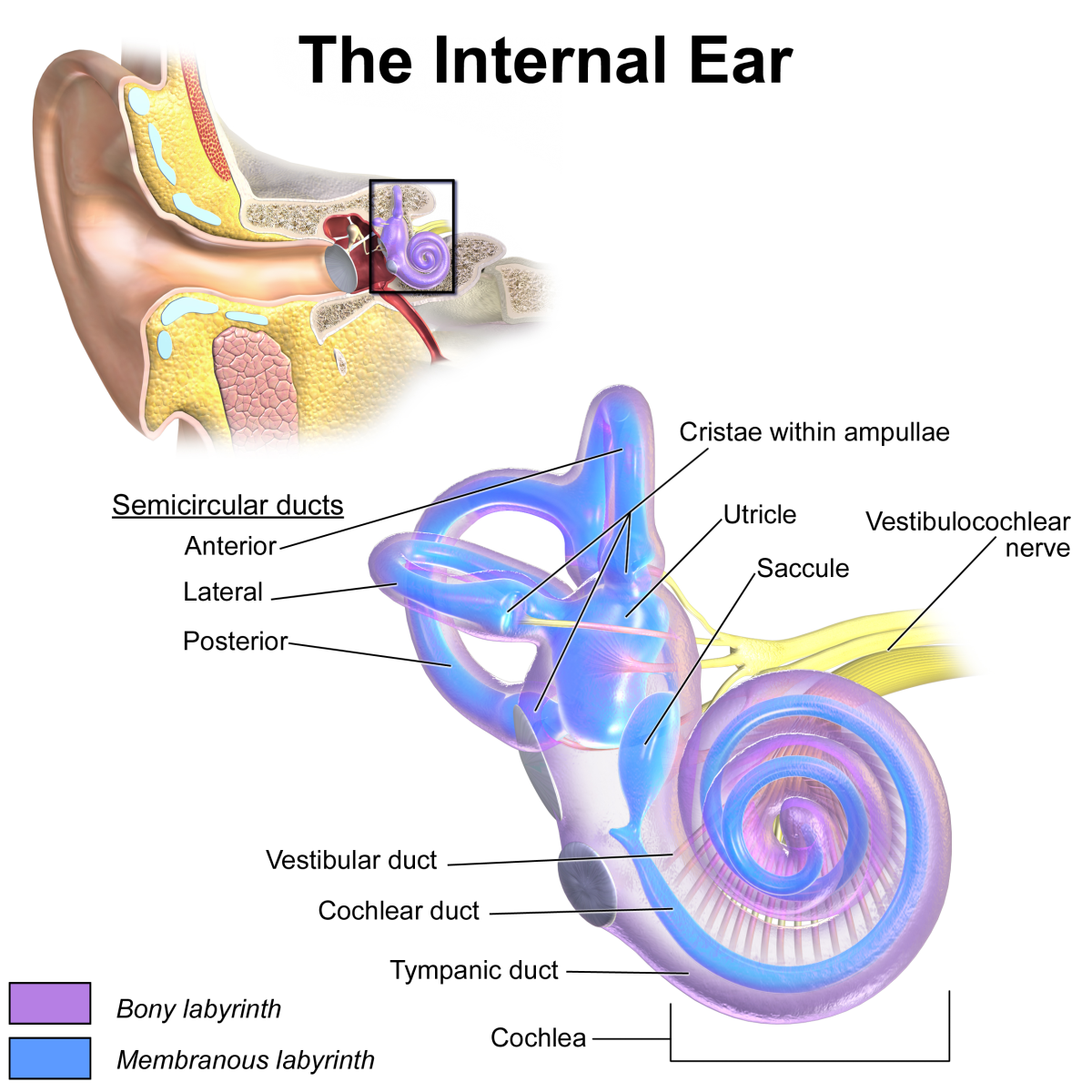Many people take balance for granted. You probably don't think twice about being able to stand up from your chair without stumbling, or walk up the stairs without tripping. In truth, the ability to achieve and maintain balance requires complex exchange between multiple sensory and motor systems.
1. The vestibular system, located in the ear, for spatial orientation
2. Vision
3. Proprioception - touch and other sensory inputs from muscles and joints
All of this information is processed by the coordination and motor areas of our brain to create instructions for the muscles to keep us balanced.
 |
|---|
The Vestibular System
You were probably taught about the five senses in school. According to more recent definitions of what a sense is, we might actually have closer to ten or even twenty. The vestibular system, located in the inner ear, provides us with the senses of gravity and rotational movement, and can be considered the main contributor to balance. In fact, its organs serve the sole purpose of sensing spatial orientation, helping to detect even the slightest head movements. This information is essential when it comes to motion, sensing where your body lies in space, and eye movements.
The system consists of the utricle, saccule, and three semicircular canals residing in the inner ear. The utricle and saccule together detect linear displacements of our head, with the utricle sensing movement in the horizontal plane and the saccule in the vertical plane. For instance, when you are walking, your utricles detect that you are moving forward in a linear motion, and the saccules sense the up-and-down bobbing accompanying each step. Both organs contain hair cells, whose very thin hairs project into a gelatinous bubble and sense gravity. The hairs bend with the gelatinous structure and the cells encode this as a signal which is transmitted through a nerve to the brain. This is like sticking your index finger into jelly: if the jelly shifts left or right, your finger will be pulled along with it and bend in the same direction, but your hand will remain still. Thus you can sense that your finger's position has changed with respect to your hand, and this message can be transmitted via nerves to your brain.
 |
|---|
The three semicircular canals found on each side of your head function in a similar fashion, except they detect rotational movement. The canals are filled with fluid that moves when the head does, and displaces the hairs of the cells, which tell the brain about the movement. Thanks to the semicircular canals, utricle and saccule, we are able to sense gravity and the spatial orientation of our head. Try closing your eyes for a few seconds. You won't fall down off your chair - partly because you feel your feet on the ground and remember that the ground is downwards - but also because your vestibular system is telling you which way is up, and your muscles work to keep your body upright based on that information.
Vision
The visual system also plays an important role in balance. Sensory cells in the retina contribute to spatial orientation by responding to specific visual cues, like the vertical alignment of trees and buildings, or the closeness of an object. The visual and vestibular systems are constantly exchanging information to ensure that they agree on the body's spatial orientation, and to filter out redundant information so your eyes keep focused on their target. Try shaking a piece of paper with writing - you won't be able to read anything. Now put it down and try to read while shaking your head - you can read it now. That's because your eyes are taking into account the movement of your head (sensed by the vestibular system), and moving to cancel out the shaking. This is called the vestibulo-ocular reflex, which serves to stabilize images on the retina in the back of the eye.
The visual input is especially important in situations where the visual field provides little spatial context and the vestibular system fails to compensate. For example a person buried under snow during an avalanche, or caught underwater after a strong wave. In these cases they might be unable to know in which direction the surface is. Swimmers are advised to look in which direction bubbles are rising to, and skiers to track where their spit would fall, as a last visual resort to determine which way to escape.
Proprioception
While our eyes and inner ears allow us to achieve spatial orientation, feedback from our joints, muscles, and skin help us keep track of where our body actually is. You might find yourself holding on for support when standing on a moving bus. When your body leans, sensory neurons under the skin of your feet and palms detect the variations in pressure, allowing you to activate the muscles necessary to correct the swaying.
 Processing sensory information
Processing sensory information
The vestibular nerve sends information to the brain which can then project to motor neurons in our necks and limbs. Sensory information from our muscles, joints, and eyes is processed by the brainstem, cerebellum, and cerebral cortex - areas involved in motor coordination and processing sensory and motor input. The brain is constantly sending feedback to the muscles and eyes, making adjustments and sending instructions. Imagine pitching a baseball. You rely on past experiences (stored in the cortex in the brain) to plan your moves, and then aim and swing your arm, constantly correcting the trajectory of your hand based on feedback from your muscles, eyes, and vestibular system to your brain. Once the baseball is thrown you might stumble forward from the momentum and use your entire balance system to regain equilibrium.
Balance disorders
Because achieving equilibrium involves multiple sensory and motor systems, there are many ways something can go wrong. Most commonly two systems send conflicting information, resulting in nausea, dizziness or motion sickness. Have you ever spun around and felt like the world kept spinning around you when you stopped? That's because the fluid inside your semicircular canals keeps spinning from the momentum and activates hair cells, signaling that you're spinning around. Meanwhile, your eyes signal that you aren't spinning anymore and you end up feeling dizzy. Dancers have learned to avoid dizziness when performing fast rotations by fixing their gaze on a single point, a technique called "spotting". Another example would be looking out a train window watching a nearby train depart, and perceiving that your own train is moving when it isn't. The visual system is telling you that your train is moving and the neighbouring train is stopped, while the vestibular system senses that your train is immobile As a result you might feel slightly disoriented for a few seconds.
While these sensations are typically short-lived, some people experience dizziness and vertigo periodically. Vertigo, the false impression that you are spinning or the world is moving, is caused by dysfunction of the vestibular system (which could be due to injury, Ménière's disease, or infection for instance). People with vertigo may experience difficulty performing simple daily tasks that require proper balance, and rely on their vision to stand and walk. Some patients have reported being unable to get out of bed for entire days during particularly acute episodes of vertigo. Fortunately, the disorders that cause vertigo can often be treated with medication and rehabilitation therapy, and sometimes symptoms even disappear spontaneously.
There is still much to learn about vertigo and balance, which makes these very active areas of neuroscience research. The ability to achieve and maintain equilibrium is not to be taken for granted. Balance isn't just for acrobats and yoga instructors. The fact that you can read this is proof that you are a skilled balancer, and have been practicing your entire life.
 |
|---|
- Previous The science of political correctness
- Next Your Brain the Liar









Comments
Intelligence in real sense is
Intelligence in real sense is to optimize environmental challenges. Tight Rope Walkers from high heights exist in higher sensory and muscular coordinated existence with brain providing instant ability to integrate data.
So is the case with men catching Cobras and confronting wilderness etc.
Add a comment